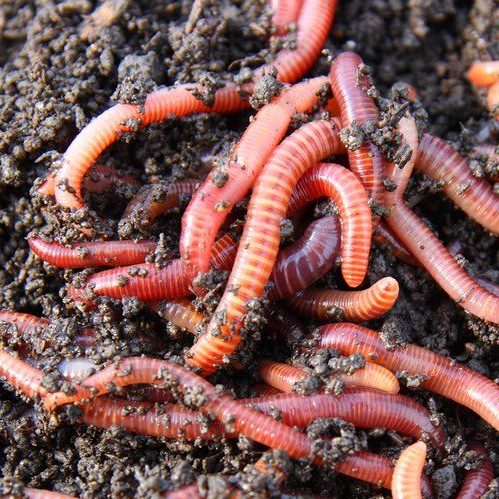Enjoy Healthy, Thriving Grass with the Help of Red Wiggler Express Lawn Care Tips
Red Wigglers: The Unsung Heroes of Organic Waste Recycling
Red wigglers, or Eisenia fetida, offer as essential representatives in the organic waste reusing process, transforming thrown out products right into valuable vermicompost. Their effective breakdown of raw material not just enhances soil high quality however likewise adds to lasting waste monitoring techniques. As the world significantly looks for services to fight waste accumulation and boost agricultural performance, recognizing the function of these worms comes to be vital. What devices enable them to prosper in compost settings, and just how can they be successfully used in both property and industrial setups? Exploring these inquiries discloses the broader ramifications of vermicomposting in our ecological landscape.
What Are Red Wigglers?
The remarkable durability of red wigglers, medically called Eisenia fetida, underscores their essential role in organic waste recycling. These small, reddish-brown earthworms are normally found in decaying organic matter, such as garden compost piles and manure stacks. Lake Hickory Bait. Unlike various other earthworm types, red wigglers thrive in nutrient-rich environments and are very effective at breaking down natural products, making them essential for vermicomposting

(Red Wiggler Express)In addition to their role in waste decrease, red wigglers add to soil health by boosting dirt structure and oygenation through their tunneling activities (Lake Hickory Bait). Their presence in composting systems not just boosts decay rates yet likewise advertises a lasting strategy to throw away monitoring, highlighting their value in environmental preservation efforts
Benefits of Composting With Worms
Composting with worms, especially red wigglers, supplies numerous advantages that improve both waste monitoring and dirt health and wellness. First, these worms effectively break down natural waste, transforming it into nutrient-rich vermicompost that enhances dirt. This process speeds up decomposition, permitting a faster recycling of cooking area scraps and other organic materials compared to conventional composting methods.
In addition, the vermicompost produced by red wigglers is bristling with advantageous microbes, which assist boost dirt framework, oygenation, and wetness retention. This boosts the overall health of plants, promoting strenuous growth and raised yields in yards and agricultural settings. Additionally, making use of worms in composting minimizes the manufacturing of greenhouse gases, such as methane, adding to an extra sustainable waste management system.

Exactly How to Begin Vermicomposting
Establishing a vermicomposting system is an uncomplicated process that can yield substantial benefits for both waste management and dirt enrichment. To begin, pick an appropriate container, such as a plastic bin or wood box, with appropriate air flow openings to make certain correct air flow. The measurements need to preferably be about 2 feet by 3 feet, permitting sufficient space for the worms to thrive.
Next, prepare bedding product, which can include shredded paper, cardboard, or coconut coir. This bed linen needs to be dampened to produce an appropriate environment for the worms. As soon as the bed linens remains in location, introduce red wigglers (Eisenia fetida) into the container, commonly around one pound of worms for every square foot of area.
Adhering to the positioning of worms, add natural waste, such as fruit and veggie scraps, coffee grounds, and crushed eggshells. With these actions, you will effectively initiate a vermicomposting system that contributes to lasting waste management and improves your soil.
Maintaining a Healthy And Balanced Worm Bin
(Lake Rhodhiss Bait)Keeping a worm bin growing needs normal interest and treatment to make certain the wellness of the red wigglers and the efficiency of the composting procedure. Proper upkeep begins with monitoring the dampness levels; the bin needs to be moist however not soaked. An excellent guideline is to keep a consistency similar to a wrung-out sponge.
Carefully mixing the bed linen and food scraps every couple of weeks avoids compaction and ensures that all worms have access to oxygen. In addition, it is vital to feed the worms appropriately.
If the bin becomes too warm or cool, the worms might come to be worried. By carefully handling these elements, one can preserve a durable and efficient worm bin.
Effect On Lasting Living
The successful upkeep of a worm container not only benefits the wellness of red wigglers however also contributes substantially to sustainable living practices. By reusing organic waste, such as kitchen area scraps and backyard particles, red wigglers assist draw away significant amounts of material from garbage dumps. This reduction in waste not just decreases greenhouse gas exhausts however likewise lessens the environmental worry connected with waste management.
In addition, the castings created by try here red wigglers function as a nutrient-rich organic fertilizer, boosting soil health and wellness and advertising plant development. This natural choice to chemical plant foods supports sustainable agriculture and gardening techniques, reducing dependence on artificial inputs that can damage communities. Additionally, worm composting cultivates understanding of waste monitoring, motivating people and communities to adopt more sustainable habits.

Final Thought
In summary, red wigglers function as vital contributors to organic waste recycling with their reliable disintegration of natural products. Their capacity to generate nutrient-rich vermicompost boosts dirt wellness and sustains sustainable agricultural practices. By integrating vermicomposting right into waste monitoring strategies, people and neighborhoods can substantially minimize waste while promoting environmental sustainability. The role of Eisenia fetida in promoting healthy and balanced communities underscores the significance of these organisms in attaining lasting living and boosting dirt fertility.